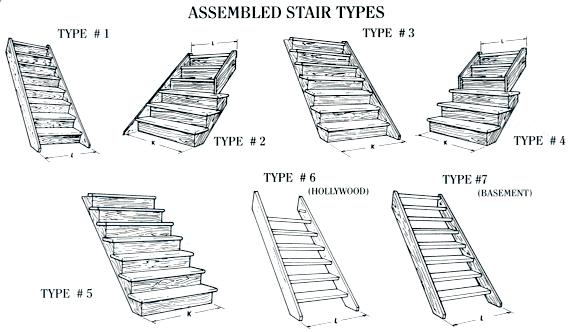Stairs can be intimidating. There are so many choices, pieces, parts, and they all have to go together safely and have a perfect fit. Finally, there’s a solution, pre-built stairs and stair parts from Curtis Lumber!
Wood Varieties
Another choice when considering stairs is the type of wood of which they are made. If you are going to finish your stairs with carpet, consider a carpet grade Southern Yellow Pine. If you are painting, a primed finish is available. While more expensive, Solid Hardwood stairs make for an elegant addition to any home. Curtis’ stair department offers stairs in 11 standard wood options, red oak, hard and soft maple, poplar, beech, cherry, mahogany, knotty pine, hickory, hemlock, and alder. Other custom varieties are available.
Pine: Southern Yellow Pine is the most common material used to make stairs because of its strength and cost. Because its economical, there are several grades of wood.
Carpet Grade: This pine is used for stairs intended to be covered with carpet, or for basement stairs, where cost outweighs aesthetics. Carpet-grade pine is knotty and may have drastic color variations, as well as voids of up to an inch in diameter filled with putty.
Paint Grade: This grade has fewer knots and less checking that carpet grade pine. There may be some graying or discoloration in the wood as it will be covered with paint.
Stain Grade: For a uniform grain and minimal small knots choose stain grade. This wood should be considered the minimum for a finished staircase.
Clear Pine: The highest level of pine available is clear. In clear pine, the grain is vertical and contains no knots. It is expected that a clear finish will be applied to the wood and they will be in a highly visible area.
Poplar: Color variation and distinctive graining is common in poplar. However, it accepts paint well and is nearly clear. Because of these characteristics, poplar is commonly used in painted or carpeted stairs. It is the lease expensive of the hardwoods.
Hardwoods: Oak, Cherry, and Maple are the most popular types of hardwoods. When stairs are made out of these materials, they are considered “finish grade”. It is expected that the stairs will be viewed as a showpiece in the room and the wood must be of exceptional quality. Because of this, only wood with knots and flaws up to 1/8″ in size are accepted.
Staircase Components
The three main parts of a staircase are tread, riser, and stringer.
Tread: The part of the staircase, horizontal to the floor, that a person steps on while walking between floors. Usually has a bull nose edge finish.
Riser: Risers work as a backing to the tread to keep the foot from traveling past the edge of the tread. They are vertical to the floor.
Stringer: The purpose of the stringer is to contain both the tread and the riser and provide structure to the staircase. This component runs at a diagonal from floor to floor.
Types of Staircases
There are 6 standard stair types that are used in most practical applications. Custom designed stairs are also available to showcase the unique decor of your home.

Box: A complete boxed in stair with housed stringers on both sides. On this stairway, the ends of each tread and riser are installed into recessed stringer routings creating a box appearance.
Open 1 Side: One side of these stairs is closed or boxed in. The opposite side is open with all returned end treads. On the open side, the wall usually runs underneath the stringer for support. These stairs are considered to be more decorative than the box type because the balusters will run directly into the treads.
Open 2 Sides: A decorative stair design, each tread is mitered and open on both sides. There is not a boxed in section anywhere on this stair type. Walls typically run beneath both sides of this stair.
Combination: These stairs have both boxed in and open sections. The amount of returned end open treads is determined by location of the finished wall line. This configuration is common when the stairs run against a wall and then into an open room.
Platform: Multiple sets of stairs that meet on a landing to meet space limitations and accommodate room layout. They are made up of 2 sets of stairs, boxed, open, or combination.
Circular/Curved: Any of the above designs can be made in a curved staircase. On this type the treads are slightly pie shaped. The shape causes the staircase to have a radius. When considering a curved staircase, be sure to get advice from a Curtis Lumber stair expert.
Measuring
There are some simple measurements and calculations needed in order to estimate and build your stairs. If you’d like to speed along the estimate process, you can take them yourself. Check out our measuring guide to walk you through the process.
